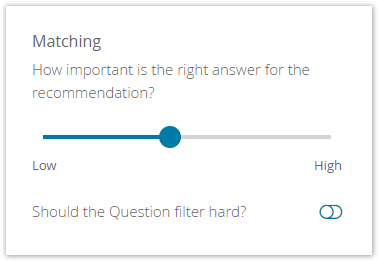The Matching settings determine how strong a question influences the result list in the recommendation phase of your Product Guide in comparison to other questions in your guide. This page gives you an overview of the available settings, explains the main concepts of matching and filtering in the Workbench and finally provides several examples to explain furthermore possible outcomes when using these settings.
Table of Contents:
Setting Overview
The Matching settings can be found in the detail view of your Question under Matching and Reasoning. You can set the Match Weight with slider or toggle the Filter Mode with Should the Question filter hard? The image below image below shows you the Detail View within the Concept Board:
Match Weight
With the aid of the match weight slider you can decide how important a Question should be for the product result list.
For example a question about your gender can be more important than a question about a color. That means that a matching answer about the gender has a higher weight than a suitable answer about the color. This results in a higher score for products with the requested gender which further results in a higher spot in the product recommendation list (see Matching Examples below).
Filter Mode
Furthermore, you can decide how the results of the Question should be represented in the product recommendation. That means that you can enable or disable a hard filtering. With an active hard filter all products which not fulfill the user-selected Answer Options are not shown in the recommended result list. For example this can be useful for a Question which requests the users gender.
A deactivated hard filter does not remove any products. The difference is that these products do not get any fitting points and as a consequence are ranked lower than products which fulfill these criterias (see Matching Examples below).
Matching Logic
The selected value of the matching logic decides how selected Answer Options of a multiple selectable Question are handled in the result list. There are two different options to choose:
- OR:
This is the default setting. It means that each selected Answer Option from a multi selectable Question is checked whether its connected product values are fitting with a product. This is especially useful if the product attribute only contains single values (like e.g. brands). - AND:
Unlike the "OR" logic, the "AND" logic checks if a product fulfills all selected Answer Options. This is only useful if a product attribute contains multiple values (like e.g. colors).
Important
Selecting the "AND" value is only possible for multi selectable Questions. Furthermore the product values also should contain multiple values. Without these fulfilled constraints the "AND" logic should not be used.
Examples:
- GOOD: Question about colors of a jacket with two selected Answer Options "blue" and "grey". The corresponding product attribute color has multiple values (e.g. "blue,grey", "green, black", etc.). Thus a product can be found that fulfills both color wishes.
- BAD: Question about car brands with two selected Answer Options "Mercedes" and "Audi". All cars only have exactly one brand. That is why an "AND" logic would result in getting negative reasons for the not fulfilled brand. As a consequence there would not be any top recommendation.
Alternative Answer Options
An alternative Answer Options describes an Answer Option which is no the best possible Answer Option to match with the product but is also not bad enough to count as a totally wrong Answer.
Let's say we have a Question about colors and we have the Answer Options "blue", "cyan", "turquoise", "navy". All variants are shades of blue but with total different namings. To secure that a product with a product value "navy" do not throw a negative reason if the user selects "blue" we can add "navy" as an alternative Answer Option for "blue".
Advantages
- No negative reason texts if the alternative Answer Option was selected.
- The fitting score is lower than the score from the actual Answer Option. Thus products which fulfills the requirements of the actual Answer Options are ranked higher than than product which only fulfills the alternative Answer Options.
- The fitting score is higher than the score from Answer Options which are not part of the alternative Answer Options or the actual Answer Option itself.
Note
Only Answer Options within the same Question can be chosen as alternative Answer Options.
Examples
| Question | Which color? | Which type of break? |
|---|---|---|
| Users Answers | blue | carbon |
| Match Weight | 1 | 2 |
Filter Mode: Hard filter = OFF for both Questions
| Product Result List | Color | Break Type | Fit |
|---|---|---|---|
| P1 | blue | carbon | 3 = 1 + 2 |
| P2 | green | carbon | 2 = 0 + 1 |
| P3 | blue | steel | 1 = 1 + 0 |
| P4 | green | steel | 0 = 0 + 0 |
Filter Mode: Hard filter = ON for the Question "Which color?"
| Product Result List | Color | Break Type | Fit |
|---|---|---|---|
| P1 | blue | carbon | 3 = 1 + 2 |
| P3 | blue | steel | 1 = 1 + 0 |

